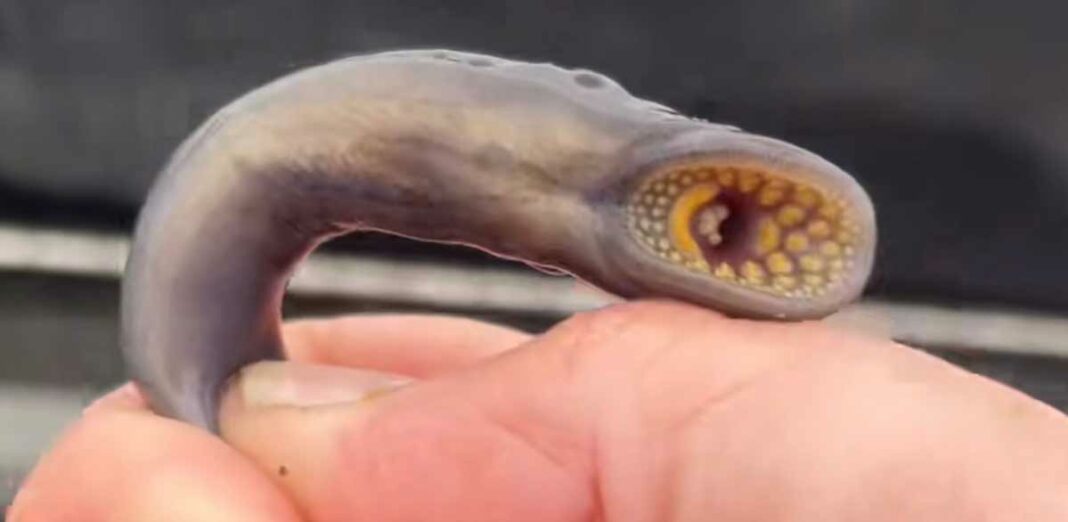MICHIGAN—While sea lamprey populations have made a significant comeback in the Great Lakes during the COVID-19 pandemic, a Great Lakes Fishery Commission (GLFC) representative is optimistic their numbers will once again be controlled in the next few years.
“I am cautiously optimistic that, even with the spike in their population during the COVID-19 pandemic, we can drive the numbers back down in a few years,” said Mark Gaden. “We are now once again very well positioned to hit them hard in terms of control measures.”
Mr. Gaden noted with sea lamprey, “the bottom line is that sea lamprey are here to stay based on the abundance of spawning and food supply available to them. Since 1958, the US and Canada have been working through a joint working partnership, undertaking a sea lamprey control program that has been very successful. No where else in the world has this program been as successful, and we have been able to reduce the populations between 90-95 percent from before the time control measures were first put in place.”
Mr. Gaden said this has been done via two techniques: “One is the installation of dams and barriers, something we have had nothing to do with, but it prevents adult sea lamprey from getting to their spawning areas.”
The second technique, “the workhorse method, is to use lampricide applied in streams where lamprey larvae are that kills them before they get to adulthood and can go out and kill fish species,” said Mr. Gaden.
“The Department of Fisheries and Oceans (DFO) is headquartered in Sault Ste. Marie and they, along with the US Fish and Wildlife Service, carry out the lamprey control program,” continued Mr. Gaden.
“Normally we jointly put together a list of streams that we are going to treat with the lampricide in a particular year—110 Great Lakes streams, on a four-year rotation,” explained Mr. Gaden. “We target the streams on a rotational basis, with each treatment killing 98 percent of the larvae in the stream or river.”
However, “the problem is that COVID kept treatment crews at home in both 2020 and 2021,” said Mr. Gaden. “In 2020 we only carried out the lampricide in a handful of streams, 25 percent of streams were treated, so it means 75 percent of streams were not treated. And in 2021, with travel restrictions still in place, crews carried out about three-quarter of the treatments.”
“In 2022 and 2023 we are back to normal, and we have even ramped up our treatment schedule,” said Mr. Gaden. “The sea lamprey spawners in 2022 are the survivors from the year 2020.” He explained that with the lack of lampricide treatments in 2020 and 2021, it provided for a significant spike in lamprey survivors.
“This year and in 2024, we will see increases in the populations, because of the 2020-2021 treatment seasons being curtailed due to the pandemic,” explained Mr. Gaden. “On the negative side it means more lamprey and fewer fish, as they have taken advantage of the years we couldn’t carry out treatments.”
“There are two positives,” said Mr. Gaden. “In the years leading up to 2010-2019, we had been increasing controls and had driven the numbers of sea lamprey down to historic lows. And starting in 2022 and this year we are back to full force and have been trying to make up ground. I am cautiously optimistic we can drive the COVID spike back down in a matter of a few years. We are very well positioned to hit the sea lamprey hard.”
Mr. Gaden said all of the Great Lakes were affected with the spike in sea lamprey populations. “Lake Ontario was really susceptible to the spike and lakes Huron and Michigan were definitely affected while Lake Superior was affected, however, not as substantially. If you talk to anglers in Lake Ontario, for example, the sea lamprey have had devastating effects on the fish populations.”
“We’re very happy that they’re not cute like bunnies, because it would be much harder to convince people that we need to rid the Great Lakes of sea lamprey,” Greg McClinchey, legislative affairs and policy director of the GLFC, told the Wall Street Journal. “They are unquestionably the stuff of nightmares.
In the freshwater environment of the Great Lakes, sea lamprey do not have natural predators, and they are much more deadly to the fish they feed on. A lamprey uses its suction cup mouth to attach to prey, including trout, whitefish, perch and sturgeon. With its sharp tongue, the lamprey rasps away at the fish’s flesh to feed on its blood and body fluids, according to the National Oceanic and Atmospheric Administration. One sea lamprey can kill 40 pounds of fish per year. Though females die shortly after spawning, they can lay as many as 100,000 eggs. By the 1960s, the creatures had devastated the upper Great Lakes trout fishery.
Lampricide, a pesticide discovered in 1957, is used to control the sea lamprey population in streams where their larvae live, along with traps and barriers. At the concentrations used, lampricide affects only lampreys.





